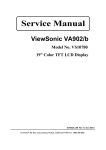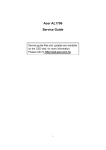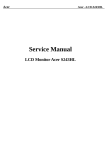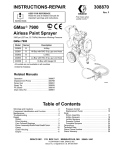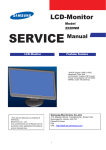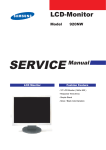Download Acer P223 Service manual
Transcript
Acer Service Manual Service Manual LCD Monitor Acer P221W/P223W -0- 1 Service Manual Versions and Revision No. Version Release Date Revision 1 1.0 2007/06/08 Initial Release Copyright Copyright 2006 InnoLux Tech. Corp. Ltd All Rights Reserved This manual may not, in whole or in part, be copied, Photocopied, reproduced, translated, or converted to any electronic or machine readable form without prior written permission of InnoLux Tech. Corp. Ltd. Acer P221W/P223W Service Manual 1 Acer Service Manual Table of Contents CHAPTER 1- PRECAUTIONS & SAFETY NOTICES ..................................................................................................................... 3 1. SAFETY PRECAUTIONS............................................................................................................................................................. 3 2. PRODUCT SAFETY NOTICE ...................................................................................................................................................... 3 3. SERVICE NOTES.......................................................................................................................................................................... 3 CHAPTER 2- SERVICE TOOLS & EQUIPMENT REQUIRED ..................................................................................................... 4 CHAPTER 3- CIRCUIT THEORY ...................................................................................................................................................... 5 2. INTERFACE BOARD DIAGRAM ................................................................................................................................................... 5 3. ELECTRONIC CIRCUIT THEORY.......................................................................................................................................................... 6 CHAPTER 4- DISASSEMBLY & ASSEMBLY ...................................................................ERROR! BOOKMARK NOT DEFINED. 1. EXPLODED DIAGRAM ................................................................................................................ ERROR! BOOKMARK NOT DEFINED. 2. DISASSEMBLY BLOCK ............................................................................................................... ERROR! BOOKMARK NOT DEFINED. 3. ASSEMBLY BLOCK ..................................................................................................................... ERROR! BOOKMARK NOT DEFINED. CHAPTER 5- TEST AND ADJUSTMENT ........................................................................................................................................ 12 1. 1.1 1.2 1.3 1.4 1.5 1.6 1.7 2. 2.1 3. 3.1 3.2 3.3 3.4 3.5 3.6 3.7 3.8 3.9 4. 4.1 4.2 5. 5.1 5.2 5.3 5.4 6. GENERAL POINTS ............................................................................................................................................................... 12 TEST EQUIPMENT OR TOOL ................................................................................................................................................ 12 PRESET TEST PATTERN ....................................................................................................................................................... 12 AC INPUT ............................................................................................................................................................................. 12 OBSERVATION DISTANCE .................................................................................................................................................... 12 KEY FUNCTION DESCRIPTION ............................................................................................................................................ 12 BURN-IN (AGING) PATTERN ................................................................................................................................................ 13 WARM UP ............................................................................................................................................................................ 13 INPUT SIGNAL...................................................................................................................................................................... 13 VIDEO SIGNAL INPUT .......................................................................................................................................................... 13 FUNCTION CHECK ............................................................................................................................................................. 14 OSD FUNCTION TEST ......................................................................................................................................................... 14 SCREEN PICTURE CHECK ................................................................................................................................................... 15 AUTO COLOR BALANCE ...................................................................................................................................................... 15 TIMING CHECK ................................................................................................................................................................... 15 POWER CONSUMPTION FUNCTION TEST ............................................................................................................................ 15 VGA CABLE DETECT TEST................................................................................................................................................. 15 HI-POT TEST ........................................................................................................................................................................ 15 GROUNDING TEST ............................................................................................................................................................... 15 BUMPING TEST .................................................................................................................................................................... 15 DISPLAY CHECK.................................................................................................................................................................. 15 PANEL FLICKER CHECK ...................................................................................................................................................... 15 PANEL DEFECT INSPECTION ............................................................................................................................................... 16 PICTURE CHECK................................................................................................................................................................. 17 CHECK BRIGHTNESS UNIFORMITY...................................................................................................................................... 17 COLOR TEMPERATURE CHECK .......................................................................................................................................... 18 BRIGHTNESS OUT (VIDEO SIGNAL INPUT 700MV ± 2%).................................................................................................... 18 DDC DATA CHECK .............................................................................................................................................................. 18 AUDIO CHECK .......................................................................................................................................................................... 19 6.1 6.2 AUDIO SOUND CHECK ......................................................................................................................................................... 19 AUDIO CONTROL TEST......................................................................................................................................................... 19 CHAPTER 6- TROUBLE SHOOTING.............................................................................................................................................. 20 ATTACHMENT 1- BILL OF MATERIAL......................................................................................................................................... 26 ATTACHMENT 2- SCHEMATIC....................................................................................................................................................... 27 ATTACHMENT 3- PCB LAYOUT ..................................................................................................................................................... 36 2 Acer Service Manual Chapter 1- PRECAUTIONS & SAFETY NOTICES 1. SAFETY PRECAUTIONS This monitor is manufactured and tested on a ground principle that a user’s safety comes first. However, improper used or installation may cause damage to the monitor as well as to the user. WARNINGS: z This monitor should be operated only at the correct power sources indicated on the label on the rear of the monitor. If you’re unsure of the power supply in you residence, consult your local dealer or Power Company. Do not try to repair the monitor by yourself, as it contains no user-serviceable parts. This monitor should only be repaired by a qualified technician. Do not remove the monitor cabinet. There are high-voltage parts inside that may cause electric shock to human bodies. Stop using the monitor if the cabinet is damaged. Have it checked by a service technician. Put your monitor only in a lean, cool, dry environment. If it gets wet, unplug the power cable immediately and consult your closed dealer. Always unplug the monitor before cleaning it. Clean the cabinet with a clean, dry cloth. Apply non-ammonia based cleaner onto the cloth, not directly onto the class screen. Do not place heavy objects on the monitor or power cord. z z z z z z 2. PRODUCT SAFETY NOTICE Many electrical and mechanical parts in this chassis have special safety visual inspections and the protection afforded by them cannot necessarily be obtained by using replacement components rated for higher voltage, wattage, etc. Before replacing any of these components read the parts list in this manual carefully. The use of substitute replacement parts, which do not have the same safety characteristics as specified in the parts list, may create shock, fire, or other hazards. 3. SERVICE NOTES z When replacing parts or circuit boards, clamp the lead wires around terminals before soldering. z Keep wires away from high voltage, high temperature components and sharp edges. z Keep wires in their original position so as to reduce interference. z Adjustment of this product please refers to the user’ manual. 3 Acer Service Manual Chapter 2- SERVICE TOOLS & EQUIPMENT REQUIRED 1. SIGNAL GENERATOR 2. MULTIMETER 3. SCREW DRIVER 4. OSCILLOSCOPE 5. Soldering IRON 6. SOLDER 7. VGA Cable (15pins point to point) 8. DVI Cable(DVI-D 24+1 pin) 9. Audio cable 10. Color Analyzer 11. Myson412 ISP Board 12. EDID Board 13. EDID program file 4 Acer Service Manual Chapter 3- CIRCUIT THEORY 1. Monitor Block Diagram The LCD Monitor contains an interface board, and inverter/power/Audio board, keypad board and flat panel. In Inverter/power/Audio board, power section supplies +14V & +5V for Inverter/Audio and Interface board used. The inverter section drives the backlight of panel and the DC-DC conversion. The Audio section drives speaker (2 x1W). Flat panel (LVDS interface) and CCFL Inverter/Power/Audio BD (Including AC/DC Power Supply , Inverter and Audio) Interface Board Keypad BD Host computer (DVI signal input) OPTION AC input Range 100V~240V Host computer (VGA signal input and DDC) 2. Interface BOARD DIAGRAM Interface Board Red Green Blue A/D & To LCD module Scaling & OSD Vsync Hsync MCU SDA DDC 5 EEPROM SCL Acer 3. Electronic Circuit Theory 3.1 Service Manual Switching Mode Power Supply 3.1.1 AC Current Input Circuit P801 is a connector for connecting AC Power. F801 is a fuse to protect all the circuit. AC input voltage is from 90v to 264V. R820 and R821 joined between two inputting main circuit to prevent man from shock. L801 is used to clear up low frequency wave. C801 and C806 are used to discharge the waves that L801 produced. High frequency waves are damped by C801 and C806. D801 is a rectifier which composed of 4 build-in diodes, it inverts AC to DC. 3.1.2 High Voltage to Low Voltage Control Circuit C805 is used to smooth the wave from rectifier. IC802 is a highly integrated PWM controller which build-in power MOSFET. When rectified DC high voltage is applied to the DRAIN pin during start-up, the MOSFET is initially off, and the CONTROL pin capacitor is charged through a switched high voltage current source connected internally between the DRAIN and CONTROL pins. When the CONTROL pin voltage Vc reaches approximately 5.8V, the control circuitry is activated and the soft-start begins. The soft-start circuit gradually increases the duty cycle of the MOSFET from zero to the maximum value over approximately 10ms. If no external feedback/supply current is fed into the CONTROL pin by the end of the soft-start, the high voltage current source is turned off and the CONTROL pin will start discharging in response to the supply current drawn by the control circuitry. Resistor R803, R807, R824 and R825 are for line over voltage shutdown(OV) and line under-voltage detection(UV). Resistors R801, R805, R822, R823 are for external current limit adjustment. And used to reduce the current limit externally to a value close to the operating peak current of primary about 1.35A. The mean is power will protected when the primary current over about 1.35A. When PWM is turned off, the main current flow will be consumed through D804, and ZD802, This will prevent MOSFET which built-in IC802 from being damaged under large current impulse and voltage spike. D806 and C815 to provide internal Auxiliary current to CONTROL pin during normal operation. Otherwise, error amplifier and feedback current input the CONTROL pin for duty cycle control. 3.1.3 DC_5V and DC_14V Output Circuit For DC 5V, D805 is used to rectify the inducted current. R806 and C811 are used to store energy when current is reversed. The parts including C814, C814, C822, C821, B801 and L803 are used to smooth the current waves. For DC 14V, D803 is used to rectify the inducted current. R802 and C802 are used to store energy when current is reversed. The parts including C808, C810 and L802 are used to smooth the current waves. 3.1.4 Feedback and OVP Protect Circuit Pin R of IC803 is supplied 2.5-v stable voltage. It connects to 5V and 14V output through R811, R810 and R818. R811, R810 and R818 are output sampling resistor. When the sampling voltage more than 2.5V or less than 2.5V, current of FB IC802 will change, this can change the voltage from T801. For 5VDC output OVP, ZD803 is a Zener Diode, when 5 voltage up to 5.6V, the zener current cause R819 voltage to ground is up to 0.7V, Q801 being triggered and OVP working. For 14VDC output OVP, ZD804 is a Zener Diode, when 14 voltage up to 18V, the Zener current cause R819 voltage to groung is up to 0.7V, Q801 being triggered and OVP working. The current of potential is used to make build-in diode light. Current of FB to IC802 will be changed, this can change the voltage from T801. Q802, R827, R828 and ZD801 make up of dummy loading circuit. For start-up sequence, during 5V output take place high loading first, this dummy loading circuit operated to insure 14V not be increased. 3.2 I/F Board Circuit 3.2.1 RGB CAPTURE - Signal RED,GREEN,BLUE input through CN103 #1,#2,#3, Stop DC via C110, C112 and C114, and then enter into U103 (RTD2553VH) analog input terminal #36,#33,#31, and then RTD2553VH deals with signal internally. EP106, EP107, EP108 are ESD protector to prevent U103 from ESD. - Signal DDC_SCL (series clock) inputs via CN103#15, and then passes through EP101 for ESD 6 Acer Service Manual protection, goes into U102(RTD2120) #5. - Signal DDC_SDA (series data) inputs via CN103#12, and then passes through EP104 for ESD protection, goes into U102(RTD2120) #8. - Signal TTL vertical sync. (Vsync) inputs via CN103 #14, and then clamped by EP102, passes through R164, and then goes into IC U103 (RTD2553VH) #40. - Signal TTL horizontal sync. (Hsync) inputs via CN103 #13, and then clamped byEP103, passes through FB104,R166, and then goes into IC U103 (RTD2553VH) #39. - CN103#5 is defined as cable detect pin, this detector realize passes through R159 Pull hight, go into U102#24. - U103 power is supplied by PC via CN103#9, or supplied by Monitor self. - U105 is an EEPROM IC which is memory and OSD data saved in it. 3.2.2 Buttons Control - Button “Power” on right side bezel connects to U102(RTD2120) #9 through R105, via CN101#8. - Button “Left” “Right “is ADC key,when press “Left” key, U102(RTD2120)#21 detect about 1.0~1.5V, then U102(RTD2120) know it is “Left” been pressed; when press “right” key, U102(RTD2120)#21 detect 0V, then U102(RTD2120) know it is “Right” been pressed; “MENU” “AUTO” on left side bezel connects to U102(RTD2120) #14,#22 through R110,R201, via CN101 #1, #3. - LED Indicator on Front Bezel a. When press button “power”, U102(RTD2120) #1 sends out a low potential, via R106, flow to CN901#4 on keypad, LED amber on until “ACER” logo over,then U102(RTD2120) #1 sends out a high potential, LED amber off .and then U102(RTD2120) #48 sends out a low potential,LED green on. b. When in “Suspend” mode, U102(RTD2120) #1 sends out a low potential, via R106, flow to CN901#4 on keypad ,LED amber on. 3.2.3 Realtek CHIP U103 (RTD2553VH)& U102(RTD2120) - U103 (RTD2553VH) #73~#82 output 8 bit even LVDS digital data to panel control circuit through CN105. - U103 (RTD2553VH) #85~#94 output 8 bit odd LVDS digital data to panel control circuit through CN105. - U102(RTD2120) #44 outputs Brightness “PWM” signals to control CCFL brightness. - U102(RTD2120) #39 output PPWR ”H” potential to make Q114 conducted, and then make Q112 conducted, +5V flow to CN105#1~#3 as Panel VDD . - U102(RTD2120) #46 output CCFL_ON/OFF ”L” or “H” potential to control Inverter on/off. - TCLK by Crystal 24MHz input to U102(RTD2120) #15,#16. Please refer to RTD2120 Pin Assignments table in page. 3.2.4 Regulator Circuit - +5V is from switching mode power supply for Panel used. - +3.3V generates from +5V through C102 and C104 filtering and U101 which is output +3.3V LDO for U102&U103 and U105 used. - +1.8V generates from 3.3V through C101 and C103 filtering and Q106&Q107 which is output +1.8V, for U103 used. 3.2.5 Audio circuit - Audio Signal R,L,GND input through P701,#2,#5,#1, Stop DC via C704, C706, and then enter into U701 (TDA8496L) analog input terminal #5,#1. - U701 (TDA8496L) #14,#12 output R,L audio data to Speaker through CN701. - U102(RTD2120) #47 output MUTE “H” potential to control U701on/off. - U102(RTD2120) #45 outputs Volume “PWM” signals to control U701 Volume. 4. Inverter circuit 7 Acer Service Manual 4.1 Low voltage to high voltage circuit 14VDC provides the power for IC501; the control signals Brightness and ON/OFF come from I/F board. ON/OFF signal connect to pin8 of IC501 and makes IC501 enable. Brightness signal connect to pin7 of IC501 and regulates the panel brightness, R526, D515, R529, C505 make up a network of delaying time circuit and R523, R524 make up a divided voltage network, C504 is used to dump noise. The operation frequency is determined by the external Resistor R522 and capacitor C529 connected to pin5 of IC501. BURST MODE dimming pulse frequency and duty is regulated by I/F board. C503 is used for soft start and compensation, C502, C528 are used for dump noise. The output drives, include NDR4, NDRV2, PDRV3, PDRV1 (pins1, 3, 15, 16 respectively) output square pulses to drive MOSFET U501, U502, and each of U501, U502 is consist of a N channel MOSFET and a P channel MOSFET. U501 and U502 work as full-bridge topology, it is high efficient, zero voltage switching. During start up, VSEN (pin9) senses the voltage at the transformer secondary. When VSEN reaches 3.0V, the output voltage is regulated. If no current is sensed approximately 1.5 seconds IC501 shunt off. The current flowing through CCFL is sensed and regulated through sense resistor R509, R511. The feedback voltage through R506, R507, C508 connected to Pin11 (ISEN), then compared with a reference voltage (1.5V) via a current amplifier, resulting in PWM drive outputs to full-bridge switches. 4.2 Protection circuit Over Voltage Protection: R501and R502 are connected in high voltage output connector, the divided AC voltage is inverted DC voltage through D508, R505 and C507are used to rectify wave & dump noise. Then the voltage signal reaches Pin9 VSEN of IC501, when the voltage changes, build-in PWM of IC501 will adjust output voltage. Open Lamp Protection: In normal operation, the resistors R510, R511, R512, R509 are sensed a high level AC voltage, the AC signal OP1 invert DC voltage through D509, R515, C533, and the high level DC voltage reaches the gate pin of Q502, similarly, the gate pin of Q503, Q504, Q505 has high level DC voltage. So the gate pin of Q501 has a low level voltage, and the IC501 is normal operation. Once one of signal OP1, OP2, OP3, and OP4 is low, the voltages of Q501 gate pin is high level, and make the voltage of ISEN low level, the IC501 will be shunt down. 8 Acer Service Manual Chapter 4- Disassembly & Assembly 1. Exploded Diagram 9 Acer 2. Disassembly Block Service Manual LE 2284 LCD Monitor ASSY, BASE BASE*1 BASE,RELEASE,BUTTON,LE1983*1 RUBBER FOOT *5 PLATE,BASE*1 SCREW,F,CROSS,T4*6,Zn,ROHS*6 SCREW,F,CROSS,T4*10,Zn,ROHS*4 HINGE COVER_L*1 HINGE COVER_R*1 HINGE *1 STAND-FRONT*1 STAND-REAR*1 SCREW,P,CROSS,T.T-4*12 *3 ASSY STAND SCREW,F,CROSS,M4*8,BLKNL ROHS(NYLOK)*4 ASSY FRONT BEZEL ASSYBACK COVER ASSYCHASSIS *1 PCBA I/F BOARD *1 PCBA INV.&DC-DC *1 HRN ASS'Y 8P KEY PAD*1 CABLE 30P FFC*1 Foil 60*35*T0.07*1 BOLT,#4-40x11.8,Ni ROHS *2FORW/ODVI(*4FORW/DVI) M3*5, Ni ROHS *4,P, W-WAS SCREW,P,CROSS W/W-SPR,M3*6,Zn,ROHS*1 GASKET*1 ASSY PANEL UNIT Aluminium Foil RIGHT*1 Aluminium Foil LEFT*1 FRONT BEZEL *1 BUTTON *1 LED LENS*1 BACK COVER *1 BACKCOVER,DECORA TE,COVER_L*1 BACKCOVER,DECORA TE,COVER_R*1 SPEAK*1 INNOLUX/ LCD PANEL 22" Note: The DIS assembly direction please following direction of arrowhead 10 Acer Service Manual 3. Assembly Block PCBA Power *1 SCREW PW,CROSS,W/WAS, M3*5,NI*3 SCREW,P,CROSSW/W-SPR,M3*6,Zn,R OHS*1 PCBA I/F BOARD *1 CABLE 30 PIN FFC SCREW,PW,CROSS,W/WAS, M3*5,NI*1 BOLT,#4-40x11.8,Ni ROHS *2FORW/ODVI(*4FORW/DVI) Foil 60*35*T0.07*1 GASKET*1 ASSY BEZEL*1 BEZEL*1 BUTTON*1, LENS*1 INNOLUX/ LCD PANEL 22" ASSY PANEL*1 Aluminium Foil RIGHT*1 Aluminium Foil LEFT*1 ASSY CHASSIS *1 CHASSIS *1 BRACKET,HINGE, *1 KEY PAD*1 HRN ASS'Y 8P*1 HINGE *1 STAND-FRONT*1 STAND-REAR*1 SCREW,P,CROSS,T.T-4*12 *3 ASSY, BASE BASE*1 BASE,RELEASE,BUTTON,LE 1983*1 RUBBER FOOT *5 PLATE,BASE*1 ASSYBACK COVER*1 BACK COVER *1 BACKCOVER,DECORA TE,COVER_L*1 BACKCOVER,DECORA TE,COVER_R*1 SPEAK*1 ASSY STAND*1 SCREW,F,CROSS,M4*8,BLK-NLROH S(NYLOK)*4 HINGE COVER_L*1 HINGE COVER R*1 ASSY SCREW,F,CROSS,T4*6,Zn,RO HS*6 SCREW,F,CROSS,T4*10, Zn,ROHS*4 11 LE 2284 LCD Monitor Acer Service Manual Chapter 5- TEST AND ADJUSTMENT 1. GENERAL POINTS 1.1 Test Equipment or Tool 1.1.1 1.1.2 1.1.3 1.1.4 1.1.5 1.1.6 1.1.7 1.1.8 Test pattern generator: PC or video pattern generator (Chroma-2326/2160/2130) Color analyzer: Chroma-7120 Power meter: AC Source Chroma-6408 Electrical safety tester: Chroma (Zentech) 9032A Stereo source: Music or signal generator input Auto shock fixture Temperature and humidity sensor DDC interface card and EDID file 1.2 Preset Test Pattern 1.2.1 1.2.2 1.2.3 1.2.4 Crosshatch (General-1) Gray Bar (16 & 32 levels) Full White Aging (Burn-in) Pattern: Full Red, Green, Blue, White, and Black 1.3 AC input All measurements mentioned hereafter are carried out at a normal mains voltage (90 - 264 V AC for the model with full range power supply, unless otherwise stated) 1.4 Observation Distance 1.4.1 Observation distance from eyes to panel is defined as 50cm 1.4.2 Visual distance from instrument to panel is defined as 20cm 1.5 Key Function Description 1.5.1 Control buttons on the front bezel [AUTO] [MENU] [►], [◄] [e Color ] [POWER] A. When OSD un-displays, press [AUTO] to perform auto-adjustment B. When OSD displays, press [AUTO] to return to previous level menu C. When “e Color OSD” OSD displays, press [AUTO] to exit the OSD A. When OSD isn’t shown on screen, press [MENU] to enter OSD interface.The OSD interface uses “ACER eColor Management” and “User” to instead “Contrast” and “Brightness” separately.When press “ACER eColor Management” to show “e Color OSD”,and press “User” to show OSD interface before. The translations of “ACER eColor Management” and “User” are always English. B. When OSD displays, press [MENU] to perform function of menu icon that is highlight or enter next level menu A. When “MENU OSD” displays, press these keys to change the contents of an adjustment item, or change an adjustment value B. When “MENU OSD” un-displays, press [►] to show “Audio” OSD and increase the volume, press [►] to show “Audio” OSD and decrease the volume . A. When OSD un-displays, press [e Color] to show “e Color OSD”,and press again the OSD can not disappear,but the time of “e Color OSD”disappearing is reseted 10 second again. B.When OSD disappear not including “e Color OSD”,press [e Color] to show “e Color OSD” OSD,the OSD before disappears,but the parameters of it should be saved Power on or power off the monitor 12 Acer Service Manual 1.5.2 Hot Key Operation HOT KEY OPERATION FUNCTION AUTO FACTORY MODE ◄ ► ● DESCRIPTION MENU POWE R ● ON Press [AUTO] & [MENU] at the same time, and then press [POWER] for DC power on. OSD menu will be shown with “F” on the left top. Select “F” for entering factory mode. 1.6 Burn-in (Aging) Pattern 1.6.1 Burn-in patterns are: full Red, Green, Blue, White and Black 1.6.2 Stop burn-in pattern by providing with video signal from D-sub or DVI-D connector 1.6.3 Enter or exit burn-in mode by setting “burn-in” to be “on” or “off” in the factory mode 1.7 Warm Up All test units have to be done warm up after at least 2 hours in a room with temperature of 40±5°C. (Except particular requirement) 2. INPUT SIGNAL 2.1 Video Signal Input 2.1.1 VESA Analog The video input consists of red, green, and blue signals. The video signals are analog levels, where 0V corresponds to black and 700mV is the maximum signal amplitude. Input impedance of video pins is 75 ohm ±1%. Sync signal input The capability of sync signal inputs shall include separate sync. Input impedance: 2k2 ohms the signals are defined as follow: Separate sync TTL level, Positive/Negative 2.1.2 Input signal mode PRESET TEST MODE TIMING VESA MODES Horizontal Mode VGA SVGA XGA Resolution Total Nominal Frequency +/-0.5KHz Vertical Sync Polarity Nominal Frequency +/-1Hz Sync Polarity Nominal Pixel Clock (MHz) 640*480@60Hz 800*525 31.469 N 59.941 N 25.175 640*480@72Hz 832*520 37.861 N 72.809 N 31.500 640*480@75Hz 840*500 37.500 N 75.000 N 31.500 800*600@56Hz 1024*625 35.156 P 56.250 P 36.000 800*600@60Hz 1056*628 37.879 P 60.317 P 40.000 800*600@72Hz 1040*666 48.077 P 72.188 P 50.000 800*600@75Hz 1056*625 46.875 P 75.000 P 49.500 1024*768@60Hz 1344*806 48.363 N 60.004 N 65.000 1024*768@70Hz 1328*806 56.476 N 70.069 N 75.000 1024*768@75Hz 1312*800 60.023 P 75.029 P 78.750 1152*864@75Hz 1600*900 67.500 P 75.000 P 108.000 1280*960@60Hz 1800*1000 60.000 P 60.000 P 108.000 13 Acer Service Manual 1152*720@60Hz 1488*748 44.859 N 59.972 P 66.750 1280*1024@60Hz 1688*1066 63.981 P 60.020 P 108.000 1280*1024@75Hz 1688*1066 79.976 P 75.025 P 135.000 SXGA+ 1400x1050@60Hz 1864*1089 65.317 N 59.978 N 121.75 UXGA 1600*1200@60Hz 2160*1250 75.000 P 60.000 P 162.000 WXGA 1360*768@60Hz 1792*795 47.712 P 60.015 P 85.5 1440*900(Red)@60Hz 1600*926 55.469 P 59.901 N 88.75 1440*900@75Hz 1936*942 70.635 N 74.984 P 136.75 1680*1050@60Hz 2240*1089 65.290 N 59.954 N 146.250 640*350@70Hz 800*449 31.469 P 70.087 N 25.175 720x400@70Hz 900*449 31.469 N 70.087 P 28.322 SXGA WXGA+ WSXGA+ IBM MODES EGA MAC MODES 640*[email protected] 864*525 35.000 P 66.667 P 30.240 SVGA 832*624@75Hz 1152*667 49.725 N 74.550 N 57.283 XGA 1024*768@75Hz 1328*804 60.241 N 74.927 N 80.000 1152*870@75Hz 1456*915 68.681 N 75.062 N 100.00 VGA Other MODES XGA 1024*768@72Hz 1360*800 57.669 N 72.086 N 78.434 SXGA 1280*1024@70Hz 1696*1072 74.882 P 69.853 P 127.000 2.1.3 VGA signal cable 15 pin D-sub VGA connector of signal cable. 2.1.4 Interface Analog signal: The input signals are applied to display through D-sub cable. Length: 1.8 m +/- 50 mm (fixed) Connector type: D-sub male. With DDC_2B pin assignments. Blue connector thumb-operated jack screws Pin Assignment: PIN No 1 SIGNAL PIN No. SIGNAL Red video input 9 VGA +5V 2 Green video input 10 Cable detect 3 Blue video input 11 GND 4 GND 12 Serial data line (SDA) 5 Cable detect 13 H. Sync / H+V 6 Red video GND 14 V. Sync 7 Green video GND 15 Data clock line (SCL) 8 Blue video GND 3. FUNCTION CHECK 3.1 OSD Function Test 3.1.1 Test mode: 1680x1050 @ 60 Hz 3.1.2 Test pattern: pattern #1 of crosshatch (GENERAL-1) 3.1.3 Check single key function and hot key function about key “Power”, “Menu”,” ►”, “◄ “, “Exit/Auto”, it should operate normally 14 Acer Service Manual 3.2 Screen Picture Check 3.2.1 Test mode: 1680x1050 @ 60 Hz 3.2.2 Test pattern: pattern #1 of crosshatch (GENERAL-1) 3.2.3 Select OSD menu to execute ‘Auto’ function, screen picture shouldn’t appear abnormal phenomenon and picture on screen should fit in with active display screen. 3.3 Auto Color Balance 3.3.1 Test mode: 640x480 @ 60 Hz 3.3.2 Test pattern: pattern #42 of 5-MOSAIC 3.3.3 Enter "Factory Mode" pressing "Auto color" key, and execute "AUTO". 3.4 Timing Check 3.4.1 Test mode: Refer to preset timing table and power saving mode 3.4.2 Test pattern: pattern #1 of crosshatch (GENERAL-1) 3.4.3 After change above timing and execute “Auto” function automatically, picture should fit in with active display screen. 3.4.4 Under power saving mode, LED lamp on the key board should be orange 3.5 Power Consumption Function Test 3.5.1 Test mode: 1680x1050 @ 60 Hz 3.5.2 Test pattern: pattern #41 of “WHITE” 3.5.3 Adjusting both brightness value to maximum, 3.5.4 Measure power consumption as the following Status Power Consumption LED Display Normal Standby (No H/V sync) Power off < 45W(with audio) Green < 2W Orange < 1W No display 3.6 VGA Cable Detect Test If VGA cable of LCD monitor isn’t connected to video pattern generator or PC, “NO SIGNAL” should be shown on screen. 3.7 Hi-Pot test Test condition: a. high voltage 2.3KV(DC) b. leakage current 10mA c. rising time 1 sec. d. test time 3 sec. 3.8 Grounding Test Test condition: a. test current 30A / 2 sec b. impedance < 0.1Ω 3.9 Bumping Test 3.9.1 Test mode: 1680x1050 @ 60 Hz; 3.9.2 Test pattern: pattern #1 of crosshatch (GENERAL-1) 3.9.3 To shock LCD monitor lightly at the center of rear cover and edges with 1~2kg/cm2 force for three times, no abnormal phenomenon is found on panel screen. 4. DISPLAY CHECK 4.1 Panel Flicker Check Connect LCD monitor to PC, set LCD monitor to be timing of 1680x1050@60 Hz, adjust brightness to be default value (brightness at maximum), execute “Auto” function, and then check picture of shut down 15 Acer Service Manual under windows 98 operating system, or flicker-pattern of pixel on-off. It should be that no flicker be found on panel screen. 4.2 Panel Defect Inspection 4.2.1 Test mode: 1680x1050@60Hz 4.2.2 Test pattern: Crosshatch/Full white/Red/Green/Blue/Black/16 color bar/64 gray bars 4.2.3 Display quality must be (according to DIN 13406-2 pixel fault class II) Defect Type Specification Bright dot defect THD Dark dot defect THD Total bright and dark dots THD Bright Dots – 2 Adjacent B THD Bright Dots – 3 or more Adjacent THD Black Dots – 2 Adjacent B THD Black Dots – 3 or more Adjacent THD Distance between defect dots THD Distance between Dark dots THD Major Minor Note 1: Dot defect is defined as the defective area is not larger than 50% of the dot area. Bright Dot is defined 5% transmission ND filter. Note 2: Light Leakage: There shall not be visible light around the customer’s bezel after assembly in normal View angle. 16 Acer Service Manual Defect Type Dot Shape(Particle Scratch and Bubbles in Display area or on The Polarizer) Specification Size Black spots which appear when B/L operating 0.15mm ≤ D ≤ 0. 5 mm Line Shape (Particles Scratch Fiber and Bubbles in display area or on The Polarizer) Display non-uniformity Bezel Label Screw Connecto r FPC/FFC Scratch Dirt Wrap Sunken No label Invert label Broken Dirt Not clear Word out of shape Mistake Position Not enough Limp Connection status Broken L ≤ 0.5mm and W ≤ 0.05 mm N≤3 N ≤4 L > 5mm or W > 0.1mm N=0 There should be non-uniformity through 5% transparency of filter or judge by limit sample if necessary. No harm No harm No harm No Word can be read. No Be attached on right position No No No bend on pins and damage No Check brightness uniformity 5.1.1 Test mode: 1680x1050 @ 60 Hz 5.1.2 Test pattern: pattern #41 of “WHITE” 5.1.3 Test tool: Color Analyzer Chroma7120 17 Majo r Minor ● Ignored 0.5mm < L ≤ 5mm and 0.05mm < W ≤ 0.1mm 5. PICTURE CHECK 5.1 Count (N) ● ● ● ● ● ● ● ● ● ● ● ● ● ● ● ● ● ● Acer 5.1.4 Service Manual Set brightness and contrast to be maximum, apply pattern as Fig.3, it should be the following requirement: Min. luminance of nine points (backlight) ¡Ý75% Max. luminance of nine points (backlight ) L/2 L/4 W/4 1 2 3 4 5 6 7 8 9 W/2 Fig. 3 5.2 Color Temperature Check 5.2.1 Test mode: 1680x1050 @ 60 Hz 5.2.2 Test pattern: pattern #41 of “WHITE” 5.2.3 Test tool: Color Analyzer Chroma7120 5.2.4 Set brightness to be maximum and contrast to be 50%, measure color coordinate and luminance by color analyzer as the following: Mode Chromaticity Coordinate x y 9300K 0.283 ± 0.030 0.298 ± 0.030 USER / / 6500K 0.313 ± 0.030 0.329 ± 0.030 5.3 Brightness Out (Video signal input 700mV ± 2%) 5.3.1 Test mode: 1680x1050 @ 60 Hz 5.3.2 Test pattern: pattern #41 of “WHITE” 5.3.3 Test tool: Color Analyzer Chroma7120 Set brightness and contrast to be maximum with white pattern, to measure the screen center, the light output shall be >= BL cd/m2 Mode MT170EN01 V7 BL (cd/cm2) 300 Remark TYP 5.4 DDC Data Check 5.4.1 5.4.2 EDID program Execute main program for EDID writing (refer to model type), using scanner for barcode download. 5.4.3 If writing EEPROM is successful, and then shows text "PASS" on screen; if writing EEPROM is failure, then shows text "FAIL". 18 Acer Service Manual 5.4.4 EDID data: (For example) P223 Analog 0 1 2 3 4 5 6 7 8 9 A B C D E F 0 00 FF FF FF FF FF FF 00 04 72 0D 00 00 00 00 00 1 00 00 01 03 08 2F 1E 78 EA DE 95 A3 54 4C 99 26 2 0F 50 54 BF EF 90 A9 40 71 4F 81 40 8B C0 95 00 3 95 0F 90 40 01 01 21 39 90 30 62 1A 27 40 68 B0 4 36 00 DA 28 11 00 00 19 00 00 00 FD 00 38 4D 1F 5 54 11 00 0A 20 20 20 20 20 20 00 00 00 FF 00 30 6 30 30 30 30 30 30 30 30 30 30 30 0A 00 00 00 FC 7 00 50 32 32 33 57 0A 20 20 20 20 20 20 20 00 EE 0 1 2 3 4 5 6 7 8 9 A B C D E F 0 00 FF FF FF FF FF FF 00 04 72 0D 00 00 00 00 00 1 00 00 01 03 80 2F 1E 78 EA DE 95 A3 54 4C 99 26 2 0F 50 54 BF EF 90 A9 40 71 4F 81 40 8B C0 95 00 3 95 0F 90 40 01 01 21 39 90 30 62 1A 27 40 68 B0 4 36 00 DA 28 11 00 00 19 00 00 00 FD 00 38 4D 1F 5 54 11 00 0A 20 20 20 20 20 20 00 00 00 FF 00 30 6 30 30 30 30 30 30 30 30 30 30 30 0A 00 00 00 FC 7 00 50 32 32 33 57 0A 20 20 20 20 20 20 20 00 EE P223 DVI 6. AUDIO CHECK 6.1 Audio Sound Check 6.1.1.1. 6.1.1.2. Apply audio source of test program, (1)voice ”LEFT” and “RIGHT” ;(2)500mVrms sine wave that sweep from 200Hz to 20 KHz, into audio input (light blue), it should be that L speaker sounds while “LEFT” and R speaker sounds while “RIGHT” Set the volume control (on OSD) at max (100%). It should be that no buzz or rattling sound occurs over the sweep frequency range. 6.2 Audio control test 6.2.1.1 When OSD is not on screen, press key ” ►”or “◄ “, volume adjustment bar appears on screen and value will grow or decrease and sound volume of speakers should be changed. If the functional test had been passed, adjust volume bar to be at 90% before exit OSD. After inspection, set the audio control out of OSD. 19 Acer Service Manual Chapter 6- TROUBLE SHOOTING 1. No Power & LED Off No power &LED off YES Check primary rectifier voltage NO NO Check circuit if short YES Check F801, F802, P801, D801 YES Check pin3 of IC802 voltage about 1V Check R801, R805, R822, R823, R817 NO YES Check pin2 of IC802 voltage about 2V NO Check R803, R807, R824, R825 YES Check pin1 of IC802 voltage is 5.8V NO Check R812, R816, C818 YES END 20 Check IC802, C805, T801 Acer 2. Unstable Power Service Manual U n sta b le p o w e r NO C h e ck sa m p lin g C ircu it C h e ck R 8 1 0 , R 8 1 1 ,R 8 1 8 NO C hange R 810, R 811, R 818 Y ES C h e ck th e R p in vo lta g e o f IC 8 0 3 a b o u t 2 .5 V NO NO if C h e ck th e C p in vo lta g e o f IC 8 0 3 3V Y ES C h e ck R 809, R 808, R 814, D 809 Y ES NO C h e ck p in 1 o f IC 8 0 2 vo lta g e is 5 .8 V C h e ck D 8 0 6 , C 8 1 5 if sh o rt C hange D 806, C815 Y ES NO C h e ck p in 3 o f IC 8 0 2 vo lta g e about 1V C hange R 801, R 805, R 822, R 823, R 817 Y ES END 21 C h a n g e IC 8 0 3 Acer 3. No raster Service Manual N o ra s te r Y ES L E D G re e n ? Y ES B a c k lig h t c a n n o t b e tu rn e d o n Y ES I s th e re 1 4 V d c v o lta g e o n p in 1 3 o f IC 5 0 1 ? NO C heck pow er s u p p ly Y ES Is th e re h ig h -le v e l v o lta g e o n p in 8 o f IC 5 0 1 Y ES NO Is R 5 2 6 O k ? Y ES C h e c k I/F b o a rd R 526 open NO C heck C N 501, C N 502, C N 503 and C N 504? C o n n e c tin g th e o u tp u t c o n n e c to r a g a in NO Y ES Is th e re p u ls e w a v e fo rm o n p in 1 , p in 3 , p in 1 5 a n d p in 1 6 o f IC 5 0 1 a t th e m o m e n t o f re s ta rt? NO Y ES Is O k IC 5 0 1 ? U 5 0 1 , U 5 0 2 fa il NO Y ES IC 5 0 1 fa il NO Is o k T 5 0 1 , T 5 0 2 ? T 5 0 1 , T 5 0 2 fa il Y ES C h e c k p ro te c te d c irc u it Q 5 0 1 , Q 5 0 2 , Q 503, Q 504 EN D 22 Acer 4. Black screen Service Manual Black screen NG Check power supply:pin 1,2 of CN102 Power fail YES NG Check D101,D105,Q104 Check power supply for U102 YES NG Check reset (pin4) of U102 Check C105,R113 YES NG Check crystal (pin 15,16) waveform of U102 Check X101,C108,C109 YES Check CCFLEnable(pin46) of U102 NG YES Check pin4 of CN102 YES Inverter Fail NG U102 FAIL Check R123 23 Acer 5. Bad Screen Service Manual Bad Screen OK L V DS Cable Reinsert W orkmanship NG OK Change L V DS Cable L V DS Cable NG NG NG Check Crystal: pin15,16 of U102 CheckX 101, C108, C109 OK Check the pins of U103 24 Acer 6. White screen Service Manual White screen OK LVDS Cable Reinsert Workmanship NG OK Change LVDSCable LVDS cable NG NG OK OK Check VLCD is 5V Check LVDS signal NG NG Check Panel-Enable of U102(pin39) OK U102 Fail NG Check Q114,Q112,Q113, END 25 Panel Fail Acer Service Manual Attachment 1- Bill of Material OEM PART NO DESCRIPTION PCBA,I/F BOARD(V1,EMEA),LE2284-612 W/SPK PCBA,KEYPAD BOARD,LE2284-X12 ROHS UNIT PRICE (US$) ET.LAW0C.014 ET.LAV0C.001 FOB HK 9.45 1 1 1.31 1 1 PCBA,P/I BOARD,LE2262-612 ROHS 23.52 1 1 1.02 1 1 0.42 1 1 2.11 1 1 4530303001 CABLE AUDIO 1P 6FT BLACK/GREEN 0.76 CP03B06P0 20R 4530101003 CABLE D-SUB 15P MALE 6FT 2.60 BLACK/BLUE ROH 10R 4530303001 CABLE DVI-D 18+1P MALE 6FT 4.43 PC99(BLACK)SA 80R 1 1 1 1 1 1 7900513006 00R 7900515000 00R 7909214006 00R 4303030012 HRN LVDS FFC 30P 158mm RoHS 00R 4303008013 HRN ASS'Y 8P 193mm UL1571#28 50R ROHS 4530708002 PWR CORD 16A/250V BLK 6FT VDE H05VV-F 3G 10R 7140300117 00R 7140300118 00R 7140700115 00R 7140200098 00R ASSY,FRONT BEZEL,LE2284 4.94 1 1 ASSY,FRONT BEZEL,LE2291 4.94 1 1 ASSY,STAND, LE2284 11.57 1 1 ASSY,BASE, LE2284 5.44 1 1 200.00 1 0 200.00 0 1 LCP 6311022201 22"MT220WW01-V1-G1,AM22000011 31R 01(INNO LCP 6311022200 22"MT220WW01-V0-G1,AM22000010 91R 01(INNO 26 Acer Service Manual Attachment 2- Schematic 27 Acer Service Manual 28 Acer Service Manual 29 Acer Service Manual 30 Acer Service Manual 31 Acer Service Manual 32 Acer Service Manual 33 Acer Service Manual 34 Acer Service Manual 35 Acer Service Manual Attachment 3- PCB Layout 36






































